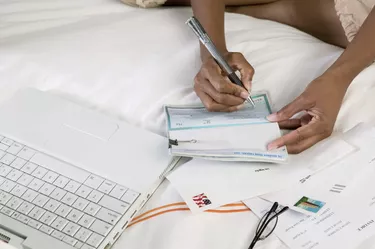
Budget problems call for one of two solutions or both. You must either increase your income or decrease your expenses to keep from going into a financial hole. Once you identify the source of the issue, you're on your way to solving your budget problems. Redo your budget to set aside money each month in a contingency or emergency fund to cover unexpected expenses and avoid future problems.
Step 1
Evaluate your current income and expenses. Set up a spreadsheet to find out where you are spending money after reviewing your check book, bank and credit card statements. Break your financial activity down into income and expenses by category. Do not forget to include your debit card expenses as well. For example, include rent, utilities, gas, telephone, car insurance and other expenses. Factor in expenses that you don't pay on a monthly basis such as car maintenance, medical expenses or vet bills. Total the expenses.
Video of the Day
Step 2
Set the fixed expenses apart from the discretionary ones. For example, rent, utilities, gas, car insurance and food are items you must spend money on each month. Discretionary expenses include items spent for personal pleasure or entertainment. When you need to cut back on expenses, look to these categories first. Instead of going out to lunch every day at work, change that to once or twice a week and bring a lunch from home to save money. If you seem to overspend on clothing, cut back on that budget or look for sales to make your money last longer. Go through all your expenditures and see what can be eliminated or decreased. Think about ways to cut back on utilities such as using lower amperage CFL bulbs or hanging laundry on a clothesline to dry.
Step 3
Sell unneeded assets. Go through the basement, garage and attic for unused items that you can sell and use to pay off debt. Hold a garage sale or use one of the online auction or classified advertising sites to sell items that you no longer use.
Step 4
Develop sources for extra income. If there is still a deficit between your income and expenses, consider getting an extra job or earning money online to close the gap. It may be necessary to cut back even more expenses in your monthly budget.
Step 5
Review your budget every few months until you get back on track. When your income exceeds your outgo, put the excess into a savings account to develop at least a six-month cushion. Avoid paying the minimum on credit card balances, because you're paying more on interest and it takes longer to pay them off. Reduce your credit card debt by starting with the account that charges the highest interest rate. When that's paid off, pay off the account with the next highest interest rate. Add what you paid for the first account into the second account's payment. In other words if you were paying $150 for the first account and $50 a month for the second account, now pay $200 a month on the second account until fully paid.
Tip
Set aside your spending money for the week in an envelope to help you stick to your budget. When it's gone, it's gone. Don't hit the ATM machine.
Things You'll Need
Financial records
Spreadsheet program
Calculator
Paper
Pencil
Warning
Create individual budget accounts to pay for things that occur periodically. For instance, if you know your car must undergo four oil changes a year, total the money needed for the year and set aside a monthly amount in your budget. Don't forget to include the car's annual licensing fees into the total figure so you don't go over budget in the month that it is due.
Keep credit card spending to a minimum and pay off the balance each month. Or use credit cards for unavoidable emergencies only.
Video of the Day